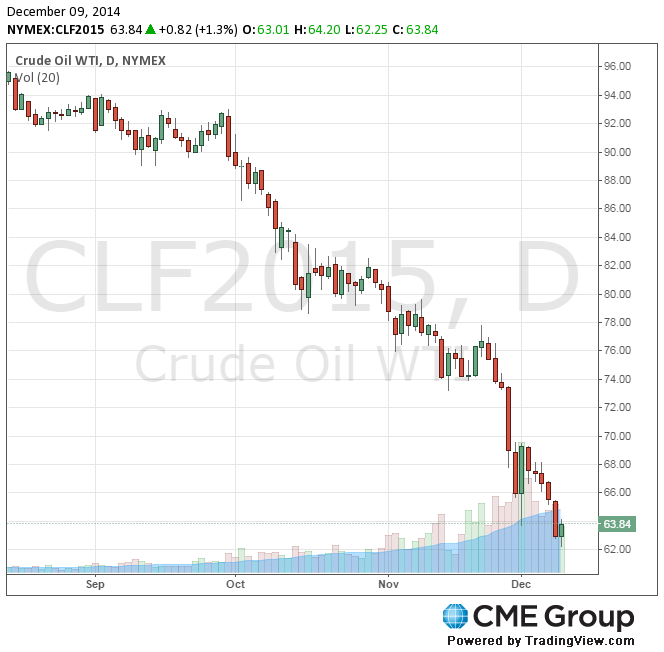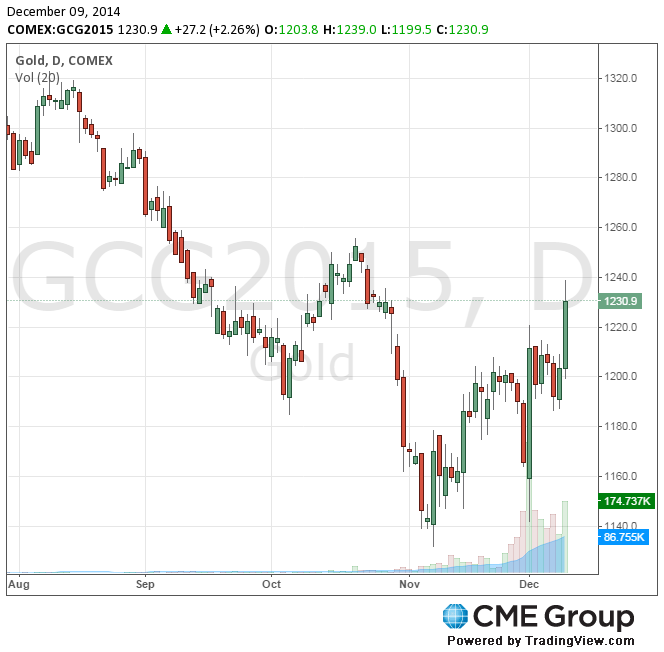Notícias do Mercado
-
16:40
Crude rises from five-year low as dollar declines
West Texas Intermediate and Brent oils climbed from the lowest levels in more than five years as the dollar fell and a technical indicator signaled the market is due for a rebound.
Futures climbed as the U.S. currency dropped from the strongest level in two years versus the euro. A weaker dollar bolsters the appeal of raw materials as a store of value. WTI and Brent are trading in a bear market as the highest U.S. output in three decades exacerbates a global glut.
The 14-day relative strength index for WTI stood at 25.4931 at 10:41 a.m. in New York, according to data compiled by Bloomberg. Investors typically start buying contracts when the reading is below 30. The 14-day RSI for Brent was 21.7609.
"The commodities are popping today because of the break in the dollar's rally," Phil Flynn, senior market analyst at the Price Futures Group in Chicago, said by phone. "The dollar's plunge is giving oil a boost in what's an oversold market."
WTI for January delivery increased 84 cents, or 1.3 percent, to $63.89 a barrel at 11:08 a.m. on the New York Mercantile Exchange. The contract closed at $63.05 yesterday, the lowest settlement since July 2009. Volume for all futures traded was 10 percent above the 100-day average. Prices are down 35 percent this year.
Brent for January settlement rose 63 cents, or 1 percent, to $66.82 a barrel on the London-based ICE Futures Europe. Volume was 4.6 percent above the 100-day average. Prices closed at $66.19 yesterday, the lowest since September 2009. The European benchmark grade traded at a $2.93 premium to WTI. The contract is down 40 percent in 2014.

-
16:20
Gold rose
Gold prices continued to rise, reaching the highest level in almost seven weeks as the weak US dollar and the decline in global stock markets increased the appeal of the precious metal as a safe haven.
Index USD, showing against a basket of major currencies, hit five-year high with the Monday 89.53 to 88.32, down 0.8%.
A weak dollar usually boosts gold's appeal as an alternative asset and reduces the cost of dollar-denominated commodities for buyers in other currencies.
The dollar index against a basket of six major currencies reduced after the article in the Wall Street Journal, that Fed officials think seriously refuse to promise to keep interest rates near zero for a long time. The Fed could announce it at the meeting next week, the article says.
Meanwhile, in Asia, in China Shanghai Composite has fallen by more than 5%, showing the maximum session decline since August 2009, as investors closed their positions amid growing fears over the health of the Chinese economy.
European stock indexes also dramatically reduced. For example, Germany's DAX fell 1.5%, while the Spanish IBEX 35 and the Italian FTSE MIB lost nearly 2%.
Despite recent gains, gold quotes, they are likely to remain vulnerable in the short term amid signs that the strengthening of the US economic recovery may prompt the Federal Reserve to start raising interest rates sooner than expected.
Expectations of growth rates on loans put pressure on gold as a precious metal with difficulty competing with the yield of interest-earning assets at higher rates.
"Gold will be difficult to continue the rally because the increase is due mainly to cover short positions. Fundamentals speaking about economic growth have not changed, and investors are betting on a decrease in quotations, because interest rates could rise soon," - said a trader in Sydney.
The cost of the February gold futures on the COMEX today rose to 1239.0 dollars per ounce.

-
11:20
Oil: Prices recover from early trading lows
Brent crude and West Texas Intermediate recovered from five-year lows reversing earlier losses. Brent Crude gained +0.62% trading at USD66.60 a barrel, and West Texas Intermediate rose +0.86% currently quoted at USD63.59 after yesterday's fall amid a price war between Saudi Arabia and Iraq. Yesterday Iraq reduced its Basrah Light Crude prices to the lowest in 11 years following Saudi Arabia who cut prices for the U.S. and Asia last week. OPEC may call an extraordinary meeting in the first quarter of next year to discuss production levels again after the last meeting in Vienna on September 27th did not yield in output cuts and prices further declined considearably. Both Brent and WTI tumbled 18 percent in November. Crude has traded in a bear market since October amid the fastest pace of U.S. production in three decades, rising output from OPEC and signs of weakening global demand.
-
11:00
Gold edges higher on lower U.S. dollar and declining equities
Gold prices appreciated a second day currently quoted at USD1,205.90 or +0,3% a troy ounce just above the important level of USD1,200 supported by a broadly weaker greenback after losing -1.1% on Friday after the better-than-expected U.S. labour market data.. Declining equity-indices, weighed down by energy shares after the oil prices further declined and disappointing German data further supported the precious metal. In times of economic uncertainty gold becomes more attractive as a protection of wealth. Markets are awaiting the FED's policy meeting next week to assess when the bank is going to increase benchmark interest rates.
GOLD currently trading at USD1,205.90
-
09:25
Press Review: U.S. shale output still surges, to add 103,000 bpd by Jan-EIA
Press Review: U.S. shale output still surges, to add 103,000 bpd by Jan-EIA
REUTERS
U.S. shale output still surges, to add 103,000 bpd by Jan-EIA
(Reuters) - Oil production from the United States' biggest shale plays is poised to keep expanding at the same breakneck pace into early next year, according to new U.S. projections released on Monday that highlighted a slow response to tumbling prices.
Oil production from the three main plays - the Bakken, Eagle Ford and Permian Basin - is set to rise by some 103,000 barrels per day (bpd) in January from December, the U.S. Energy Information Administration said.
That's just a hair below December's 105,000 bpd rise, and a faster rate than most months this year.
Source: http://www.reuters.com/article/2014/12/09/us-oil-shale-predictions-idUSKBN0JN02L20141209
BLOOMBERG
Tesla Tumbles as Gas Price Slide Spurs Demand Concerns
Tesla Motors Inc. (TSLA)'s shares have dropped 14 percent in seven trading days on growing concern that the cheapest gasoline in more than four years will damp consumer enthusiasm for the company's luxury electric cars.
A disappointing forecast of Tesla's November U.S. sales by the industry website InsideEVs.com fed the decline yesterday.
Consumers paying less at the pump may have diminished the need for vehicles that run on an electric charge and can cost as much as $100,000. Gasoline prices in the U.S. have fallen for 68 days to an average of $2.67 per gallon, according to the motoring club AAA.
BLOOMBERG
Bullion Board Seen by Council as Way to Manage India Gold Demand
India, the world's largest gold consumer after China, should start a bullion board to regulate trade and a spot exchange to offer uniform prices across the country, the World Gold Council said.
The board should manage imports, encourage exports and boost infrastructure for the industry, while the spot bourse would create a national pricing structure derived from the London fixing, the council said today in a joint report with the Federation of Indian Chambers of Commerce and Industry, an industry group.
India's bullion imports surged this financial year as tax increases and a rule linking shipments to re-exports failed to curb demand among jewelry buyers and investors. The solution to meeting Indians' enduring appetite for the precious metal lies in making better use of the gold already in the country and not restricting shipments, according to P.R. Somasundaram, managing director for the council in India.
-
